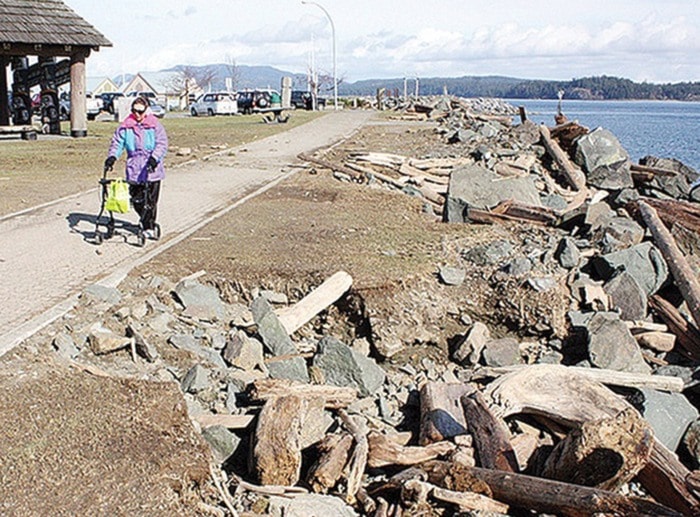City council has delayed the Ostler Park improvement project due to anticipated impacts of climate change and sea level rise.
The project, which involves replacing the riprap along the foreshore with a mechanical soft shore beach, was expected to be done in 2017 but the continued erosion of the beach prompted staff to reassess the project.
Ross Milnthorp, the city’s parks, recreation and culture manager, suggested two weeks ago that council temporarily delay upgrades at Ostler Park until the city can get a handle on downtown flooding problems.
“During the feasibility planning for Ostler Park repairs, it looked like we could accommodate sea level rise with minimal change to the park footprint,” Milnthorp said in a release. “With a revised analysis of the expected frequency of major storms and the increasing wave intensity when high winds and high tides combine, it’s in the best public interest to develop a more conservative plan to protect this key downtown park.”
At last week’s Committee of the Whole meeting, council, on city staff’s advice, approved holding off on the project until long-term solutions to mitigate flooding in the downtown core are identified.
City Manager Deborah Sargent said she understands the delay may not be welcome news to the community, but said it’s important that the public – and council – get a chance to consider modifications that will address future storm-related damage related to increased sea level effect.
“We appreciate all the time people have taken to provide input on this project, and we realize this delay might be disappointing, but it’s wise to ensure we build this project on the most solid science,” Sargent said. “New information has become available since the feasibility plan for Ostler Park upgrades was first presented. To be fiscally prudent, this project will be postponed until we have a revised design that incorporates those new realities.”
Milnthorp said that Ostler Park could play a role in addressing downtown flood control.
Council, at the recent Committee of the Whole meeting, directed staff to consider the park project in relation to solutions to downtown flooding and also approved using already-budgeted project funding for a short-term repair on the existing riprap along the shore to minimize storm damage to the Seawalk, park benches and plantings.
Council approved $1.24 million for the project, with $400,000 of that allocated for the project design. The remaining $839,000 was to go towards construction in 2017.
Of the $400,000 set aside for designs, a total of $66,078 has already been spent, but the left overs will be carried over to next year for the short-term rip rap repairs.
The $839,000 for construction will be considered by council for re-allocation to other priority projects during budget deliberations which wrap up today.
Council will also consider the bigger picture of how to protect city infrastructure along the entire length of the city’s waterfront.
“An important step in the city’s asset maintenance process will involve reviewing the scheduled replacement plans for critical infrastructure that may be affected by sea level rise to ensure that we select locations and alignments that minimize risk,” said Ron Neufeld, the city’s deputy manager and general manager of operations. “For example, over the long-term, sewer and water lines that are currently buried on the water side of the highway may be relocated farther inland to provide better protection and access.”
The city will also take a look at aging storm drains. Typically, when heavy rain, southeast winds and king tides combine, the flow of storm water slows down and results in flooding in low-lying areas.
“With rising sea levels and with more frequent storms anticipated, we can expect that our existing storm drain system will be overwhelmed more often, “Neufeld added. “As a result, we will need to make changes and improvements to the way we manage storm water within the community and particularly in those areas most affected by sea level rise.”
